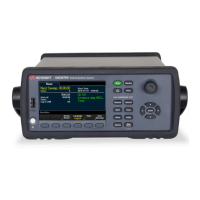Querying parameter settings
You can query the current value of most parameters by adding a question mark ( ? ) to the command. The following
example sets the trigger count to 10 measurements:
TRIG:COUN 10
You can then query the count value by executing:
TRIG:COUN?
You can also query the minimum or maximum count allowed as follows:
TRIG:COUN? MIN
TRIG:COUN? MAX
Using the MIN, MAX, and DEFparameters
For many commands, you can substitute "MIN" or "MAX" in place of a parameter. In some cases you may also sub-
stitute "DEF". For example,
VOLTage:DC:RANGe {<range>|MIN|MAX|DEF}
Instead of selecting a specific value for the <range> parameter, you can substitute MIN to set the range to its min-
imum value, MAX to set the range to its maximum value, or DEF to set the range to its default value.
SCPI command terminators
A command string sent to the instrument must terminate with a <new line> (<NL>) character. The IEEE-488 EOI
(End-Or-Identify) message is interpreted as a <NL> character and can be used to terminate a command string in
place of a <NL> character. A <carriage return> followed by a <NL> is also accepted. Command string termination
will always reset the current command path to the root level.
For every message that includes a query and is sent to the instrument , the instrument terminates the
returned response with a <NL> or line-feed character (EOI). For example, if *IDN? is sent, the response is
terminated with a <NL> after the block of data that is returned. If a message includes multiple queries
separated by semicolons (for example "*ESR?;*IDN?"), the returned response is again terminated by a <NL>
after the response to the last query. In either case, the program must read this <NL> in the response before
another command is sent to the instrument, or an error will occur.
18
Keysight DAQ970A/DAQ973A Programming Guide
1 Remote Operation

